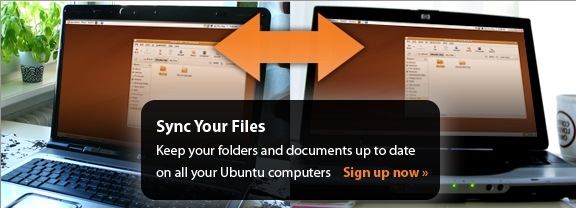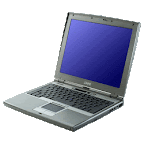Beyond just the issue of running better on low-spec machines and the argument of better screen layouts compared to Windows 7 and Windows XP (don't have to worry about OS X since Apple doesn't have a Netbook and don't seem to have plans for one either), there are some cool reasons why Linux is a good choice for Netbooks especially if you have a Google Gmail account. Considering Google is working on their own netbook-friendly operating system (Google Chrome OS) plus their phone-based operating system (Android), both of which are Linux-based, the compatibility between desktop and cloud applications should only get better.
First off, the idea of a Netbook is to be a portable laptop-like device which connects to the internet and runs common activities such as email, browsing, instant messaging and more. To help with the portability it uses an energy efficient Atom processor which runs currently around 1.6 GHz (not talking about the dual-core variety here yet). Actually, a Netbook is more powerful than most of my computers (sad, isn't it?). At least I have finally moved away from the machine with specs less than that of Motorolla's newest Droid phone!
Anyway, as the purpose of the Netbook is to interact with the internet from just about anywhere, yet many, if not most, people prefer the feel of running native apps yet still want to have things accessible via the web from other machines. This way you can, say, work on a presentation in Google Docs or Zoho, on the desktop with a nice screen and keyboard, yet pull it up on your portable Netbook for the actual meeting without having the lug this huge desktop or even supersized laptop around!
Email is probably the easiest to coordinate since it is pretty much everywhere and everyone has it. I'm not sure about Outlook Express or Live Email (or whatever it's called), but I know that the cross-platform Thunderbird can and my choice on Linux, Evolution, can access my Gmail account via IMAP. The wonderful thing about this is that just about any changes I make with my mail, move, mark as read/unread or delete as well as every email I send is ultimately stored on the IMAP server and thus is accessible from all machines I connect to it. It is also fully realized through the web interface.
What Thunderbird provides, with the Lightning add-on, and Evolution provides out of the box is the ability to connect to my Google calendars and while I have had mixed experiences, I have managed to successfully connect to my calendars in a bi-directional manner. This means, I can add/change/remove an appointment on my local client and it is changed on the server so the next manner I connect to it (application on another machine, over the web, etc.) the change will be present.
Also with an add-on in Thunderbird or included in Evolution is the ability to sync one-way all of your contacts. This is great in centralizing your contacts so you don't go to a machine to email somebody only to find out you added them on another machine instead. The shortfall of this, as far as I can tell, is that it is only one way. To add a contact you may have to go to the gmail web interface or
Google Contacts and make your changes there.
So with something like Thunderbird, or Evolution and Google account you can almost have a Microsoft Exchange-like functionality without shelling out a lot of cash.
So now we turn towards files and the cloud because let's face it, while email and personal information management (PIM) usage is fine it still doesn't help when you need to create a presentation or invoice for somebody.
So this is where
Google Docs and
google-docs-fs comes in. From the project website:
This project aims to allow you to connect to Google Docs and treat it as a file system. Combine the portability of Google Docs with the flexibility and power of using the office suite of your choice.
This will allow you to mount your Google Docs account as you would a normal filesystem. You will then be able to use it as if it were a file system on your hard disk, with all operations being transmitted seamlessly to Google Docs.
So in theory you can open your Google Doc with OpenOffice on your local machine and when it saves, it saves in the cloud! How cool is that?
Of course you'll have to keep an eye on compatibility if you plan on accessing it via the web interface but if it is only being accessed by a local client app whether from one machine or another then it may not make any difference if you add a few things that Google Docs can't handle.
Either way, I will have to test this out and get back to you on how well it works, but I'm excited.
The last piece, though, is a little bit trickier and doesn't quite work in Linux at this time. I do hope that the Linux clients will get this functionality in the near future though because I've been using this in Windows for a while and there are some really nice features missing from the Linux variant. I am talking about Picasa and
Picasaweb.
The current model of these online galleries is that you import your pictures into your local computer and then you upload what you want to the Picasaweb gallery. This is great, but you don't necessarily have the originals on your local system. If you were to take your netbook on vacation with you and upload your pics from that machine, the originals are not available on your desktop to view on the larger monitor unless you use a USB thumb drive to transfer the files from one machine to another.
Yet with Picasa 3 in Windows you can not only upload your pictures, but download the entire album as well. In this manner it matters less as to who has the original (and I would back up the originals regardless) as any system can download the entire album onto the local machine. I do not know if PicasaWeb handles RAW files. I would understand if htey do not because those files will quickly fill up the space limitation. On a good note, they just dropped the price on how much memory you can store. You get 1 GB for free and for $5 per year you can increase that by 20 GBs (so $25 per year will give you 101GB!). For a shutterbug this may be well worth the cost.
Last is something that hooks up to Google Reader. I'm practically addicted to Google Reader and the idea of entering all of those feeds into a local client sounds daunting. Not to mention applications like
Liferea only mimics the Google Reader, does not actually integrate. The best reader, and the one I'd install in a heartbeat, is the one that would work WITH my Google Reader. This way, if I read an item in the local client, my Google Reader item is marked as read, and if I read it in Google Reader then I don't want my local client to show it if I have filters to only show unread entries.
There is a project, though, which utilizes Adobe Air (which there is a Linux variant) to connect to Google Reader, called
ReadAir. While it is focused on the Windows and Mac version I really hope that they don't leave Linux out in the cold. I'll have to research this some and see how it works.
In conclusion, there are a number of apps, at least for Linux, to take your Cloud life and bring it back onto the desktop! Since I am not so keen on having dozens of web browsers opened in order to do something I like the idea of integrated native apps on the front end, but fed from Google Cloud where I can always access via browser if necessary, or another computer.


 Now, this laptop does not have any exotic hardware. I believe it has an Intel graphics and Broadcom ethernet and a Broadcom wireless card. It is a Dell Latitude D400.
Now, this laptop does not have any exotic hardware. I believe it has an Intel graphics and Broadcom ethernet and a Broadcom wireless card. It is a Dell Latitude D400.


